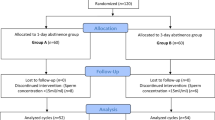Abstract
Purpose
To compare the efficacy of gradient and swim-up semen preparation techniques on pregnancy rates in couples undergoing intrauterine insemination (IUI) cycles with low dose gonadotropin stimulation with the diagnosis of unexplained or mild male subfertility.
Methods
Two hundred and twenty three couples were randomized into swim up or gradient technique groups for sperm preperation. The clinical and on going pregnancy rates per cycle and per patient were evaluated.
Results
Both clinical and ongoing pregnancy rates per cycle were significantly higher in the “gradient” group (19 % and 16.9 %) in comparision with the “swim up” group (9.7 % and 6.9 %) (p < 0.05). Clinical pregnancy and on-going pregnancy rates per patient were higher in the “gradient” group (26.1 % and 23.4 %) when compared to the “swim up” group (15.2 % and 10.7 %), (p < 0.05). In the subgroup of 191 unexplained subfertile couples with 290 cycles; the “gradient” group also revealed significantly higher clinical and ongoing pregnancy rates per cycle (21.6 % and 17.9 %) when compared with the “swim up” group (10.3 % and 7.1 %) (p < 0.05). In total of 48 treatment cycles upon 32 couples with mild male factor subfertility no significant difference were found between the two sperm preparation techniques in terms of clinical (% 5.3 vs %6.9, p > 0.05) and ongoing (% 5.3 vs %6.9, p > 0.05) pregnancy rates per cycle.
Conclusion
The gradient technique significantly improves clinical outcome in IUI cycles of unexplained subfertile couples when compared to swim up technique. In male subfertile patients, both techniques yield similar clinical outcomes.
Similar content being viewed by others
References
Hughes EG. The effectiveness of ovulation induction and intrauterine insemination in the treatment of persistent infertility: a meta-analysis. Hum Reprod. 1997;12(9):1865–72.
Cohlen BJ. Should we continue performing intrauterine inseminations in the year 2004? Gynecol Obstet Invest. 2005;59(1):3–13.
Mortimer D. Sperm recovery techniques to maximize fertilizing capacity. Reprod Fertil Dev. 1994;6(1):25–31.
Goldenberg M, Rabinovici J, Bider D, Lunenfeld B, Blankstein J. Weissenberg R. Intra-uterine insemination with prepared sperm vs unprepared first split ejaculates A randomized study Andrologia. 1992;24(3):135–40.
Dodson WC, Moessner J, Miller J, Legro RS, Gnatuk CL. A randomized comparison of the methods of sperm preparation for intrauterine insemination. Fertil Steril. 1998;70(3):574–5.
Carrell DT, Kuneck PH, Peterson CM, Hatasaka HH, Jones KP, Campbell BF. A randomized, prospective analysis of five sperm preparation techniques before intrauterine insemination of husband sperm. Fertil Steril. 1998;69(1):122–6.
Posada MN, Azuero AM, Arango AM, Raigosa GC, Cano JF, Perez AL. Sperm washing with swim-up versus gradients in inra uterine insemination (IUI): results of a prospective randomized study comparing pregnancy rates and costs. Fertility & Sterility Abstract book. 61st ASRM meeting. 2005; Vol. 84 Suppl. 1:361
Boomsma CM, Heineman MJ, Cohlen BJ, Farquhar C. Semen preparation techniques for intrauterine insemination. Cochrane Database Syst Rev. 2007(4):CD004507
WHO Healt Organization. WHO Laboratory Manual fort he Examination and Processing of Human Semen, 5th edn. Cambrdge: Cambridge University Press, 2010
Morshedi M, Duran HE, Taylor S, Oehninger S. Efficacy and pregnancy outcome of two methods of semen preparation for intrauterine insemination: a prospective randomized study. Fertil Steril. 2003;79 Suppl 3:1625–32.
Depypere H, Milingos S, Comhaire F. Intrauterine insemination in male subfertility: a comparative study of sperm preparation using a commercial Percoll kit and conventional sperm wash. Eur J Obstet Gynecol Reprod Biol. 1995;62(2):225–9.
Erdem A, Erdem M, Atmaca S, Korucuoglu U, Karabacak O. Factors affecting live birth rate in intrauterine insemination cycles with recombinant gonadotrophin stimulation. Reproductive biomedicine online. 2008;17(2):199–206.
Morrell JM. Update on semen technologies for animal breeding. Reprod Domest Anim. 2006;41(1):63–7.
Morrell JM, Moffatt O, Sakkas D, Manicardi GC, Bizzaro D, Tomlinson M, et al. Reduced senescence and retained nuclear DNA integrity in human spermatozoa prepared by density gradient centrifugation. J Assist Reprod Genet. 2004;21(6):217–22.
Sakkas D, Manicardi GC, Tomlinson M, Mandrioli M, Bizzaro D, Bianchi PG, et al. The use of two density gradient centrifugation techniques and the swim-up method to separate spermatozoa with chromatin and nuclear DNA anomalies. Hum Reprod. 2000;15(5):1112–6.
Prakash P, Leykin L, Chen Z, Toth T, Sayegh R, Schiff I, et al. Preparation by differential gradient centrifugation is better than swim-up in selecting sperm with normal morphology (strict criteria). Fertil Steril. 1998;69(4):722–6.
Author information
Authors and Affiliations
Corresponding author
Additional information
Capsule The gradient technique significantly enhanced pregnancy rates in unexplained subfertile patients with favorable sperm parameters when compared to swim up technique.
Rights and permissions
About this article
Cite this article
Karamahmutoglu, H., Erdem, A., Erdem, M. et al. The gradient technique improves success rates in intrauterine insemination cycles of unexplained subfertile couples when compared to swim up technique; a prospective randomized study.. J Assist Reprod Genet 31, 1139–1145 (2014). https://doi.org/10.1007/s10815-014-0274-4
Received:
Accepted:
Published:
Issue Date:
DOI: https://doi.org/10.1007/s10815-014-0274-4




